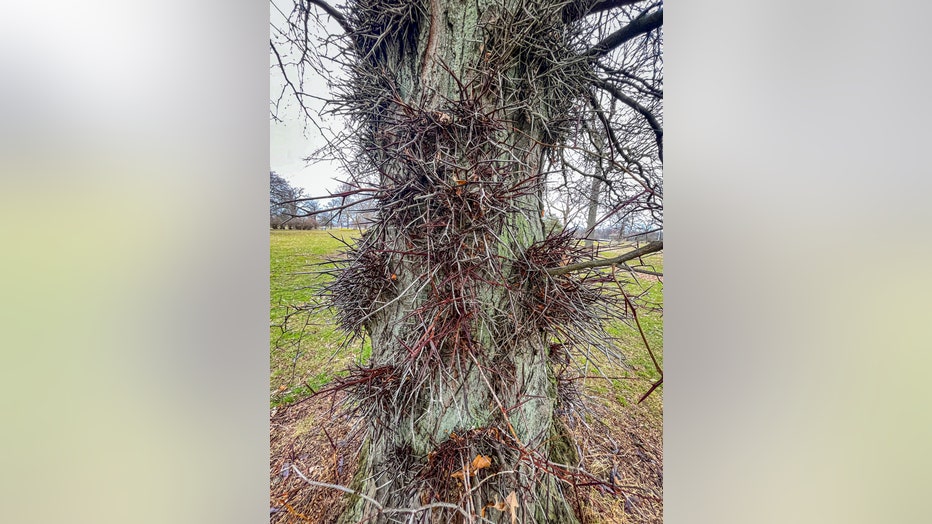Belle Isle tree's evolutionary secret is one half of ancient animal relationship

Honey Locust tree with thorns growing on Belle Isle. Photo courtesy of Coulter Stuart.
BELLE ISLE, Mich. (FOX 2) - The giant slide may not be the most dangerous thing on Belle Isle. People only need to look at the tree standing in its shadow. Protruding out of its trunk is a living reminder of the beasts that roamed North America and the legacy they left behind.
Scientists call them evolutionary anachronisms. But to the visitors of Belle Isle, they're giant thorns.
Unlike the finger-sized spikes that grow on rose bushes, these thorns can grow more than half a foot long. If thorns are meant to be a defense mechanism to keep away predators, what animal is big enough to require barbs that could impale someone?
The answer lies in the past.
A honey locust's thorns are too big to fend off nesting birds or a curious deer's snout. But if an elephant-sized animal wanted to knock over the tree, the thorns would be perfectly suited to ward off its advances.
Elephants aren't native to North America, but furry mammoths and tusk-wielding mastodons once walked the land, which is where this story begins.
"Go back only 9,000 to 13,000 years ago, the landscape had a lot of megafauna, including mammoths and mastodons, giant sloths; we had giant beavers, camel-like animals and horses," said Dr. Christopher Dick at the University of Michigan Herbarium.

Evolutionary biologists believe honey locust trees spawned these thorns to ward off mammoths and mastodons that might want to knock it down. Photo courtesy of Coulter Stuart.
Those species disappeared with the arrival of humans in North America and the end of the last ice age. Scientists know they lived in Michigan, having found the bones of woolly mammoths in a soybean field in 2015.
But in the millions of years leading up to their demise, plants and trees coexisted alongside these ancient beasts - and even used them to spread across the continent. Evolution helped pick out the traits that helped them best survive, which included using animals to disperse their seeds - while deploying defenses to protect them in the process.
Honey locust trees like the one growing on Belle Isle with its terrifying thorn clusters may be the best example of this relationship.
Southeast Michigan is actually the most-northern region where honey locust trees grow. Their distribution spans both sides of the Mississippi River and stretches all the way down to Louisiana.
People have also done their fair share of planting honey locust trees because of their hardiness in tough environments, choosing to grow them in cities. These variations have been cultivated to grow without the thorns that natural honey locust trees still produce.
While the thorns kept predators from damaging them, the seed pods that grow on their branches served as a delicious treat for those that could reach them.
Paleobotanists and evolutionary biologists believe this is why plants and trees grow fruit; as a mechanism to spread by attracting animals with a tasty meal that also includes seeds that can grow elsewhere.
After being eaten, the seeds will pass through an animal's digestive tract before being deposited somewhere else. Some seeds have to travel through the stomach where they can break down enough that by the time they're excreted, they're ready to germinate with the help of fertilizer from the accompanying manure.
"When we look at megafauna, in general, the thought is your mouth has to be bigger than the fruit," said Dr. Aly Baumgartner, a plant curator at UM's Herbarium. "(Honey locust) seed pods aren't small, so looking at the size, the thought would be a mammoth or a mastodon."
Scientists felt more certain about this relationship when they found fossilized manure from both of those species that contained the seeds of honey locust in the sample. Baumgartner put it more succinctly: "We found the seeds in the poop, the smoking gun if you will."
Honey locust trees aren't the only examples of this relationship. The Kentucky coffeetree, another North American tree species that resides in the Midwest, has its own seed pod that megafauna are believed to have eaten and helped spread. Osage Orange, a small seasonal tree native to Texas, Oklahoma, and Arkansas, also relied on these animals for dispersal.
But where honey locust trees are sought out by humans and thus continue to be planted, the other species haven't had as much luck. Kentucky coffeetree seeds are poisonous to humans and small animals. Seeds from Osage Orange trees are encased in a sticky substance that livestock typically ignore.
Without the giant sloths and mastodons to move these seeds around on their own, their ability to spread could be inhibited.
This theory isn't without controversy and scientists warn relationships like these are rarely as simple as they appear. Baumgartner said paleobotanists look at this dynamic as an ecological "just-so story" - where a narrative that cannot be tested is used to explain why things are the way they are.
"It does make a lot of sense and we do have some evidence that supports it," Baumgartner said. "But it's probably more complicated than that. That's true of most things in science, especially in biology. There's no neat way of tying a bow around it."
With thorns like what the honey locust grows, perhaps no bow would fit.


